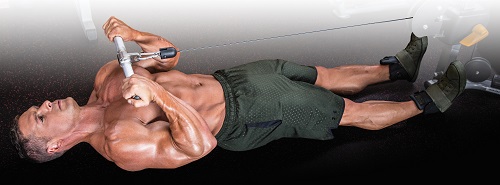Can You Truly Isolate a Muscle

You can cheat even on isolation exercises, but there are ways to make them better at eliminating assistance from other muscle groups.
When executing a single-joint exercise such as a biceps curl, you may vary between two extremes: using super-strict form or performing it very loosely with a thrust through the hips and extension of the lower back. With the former, the biceps is best isolated, meaning that the contribution from other muscle groups is minimized, but you sacrifice on the amount of weight used. With the latter, you can typically use a heavier load, but in this case, even this “isolation” exercise spreads the muscular stress among one or more muscle groups.
In this sense, some single-joint movements—aka isolation exercises—allow for varying degrees of strict form and thus are truly better at effectively isolating the target muscle than others. Strict ones aren’t necessarily better than loose ones, but you should at least be aware of the pros and cons of each.
• Standing exercises allow the greatest degree of loose form among isolation movements, which can be apparent to anyone who watches a trainer heave a too-heavy biceps curl or lateral raise. With borderline “sloppy” form, you can use more weight, but you also increase the risk of injury, and bad form can actually decrease the muscular stress on the target muscle.
The best way to incorporate cheating form with a weight you can’t handle for your target rep (say 8), is to do 5 or 6 clean reps on your own, then add just enough thrust to enable you to complete the remainder.
• Machine exercises such as the preacher-curl machine limit your ability to generate momentum and body English because the biomechanical pathway is predetermined. That also diminishes the role of stabilizer muscles, which effectively makes machine exercises better at isolating the target muscle than their free-weight counterparts, especially those done standing. Efforts to bring momentum and body English into machine exercises often mean greater stress on joints, a bad trade-off.
• Seated movements reduce your ability to effectively generate momentum through your lower body, which also makes them better at isolating the target muscle. That, of course, also comes with a cost: You can typically do standing dumbbell curls with a greater load to reach your target rep than you can do seated. Remember too that you can lean into a seated curl when alternating reps, which invites more cheating than if you did the exercise bilaterally.

• Though more uncommon, stabilizing yourself on a bench (or the floor) with cable movements pretty much reduces your ability to generate momentum altogether so long as you avoid extreme rep speeds and bouncing motions. Some machines also allow you to use a lying position. This is the safest way to execute an exercise and requires the target muscle to power through the movement unaided, so you’ll have to back off on the weight.
All these variations are useful in your toolbox of biceps exercises (and can be applied to single-joint movements of other muscle groups) and add variety to your workout. One easy superset is to start an exercise with its most restrictive version (say, the lying cable curl), and when you reach muscle failure, stand up and do as many additional reps as you can, at which point you’re now able to use a bit of body English to keep the set going. Get articles like this one delivered to your email each month by signing up for Muscle Insider’s newsletter.

